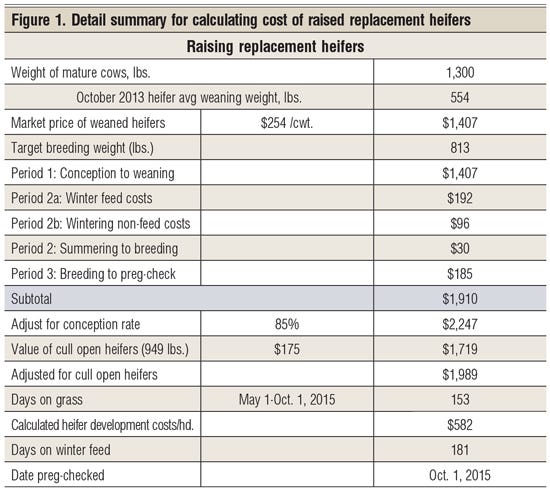Cost Of Developing 2014 Heifer Calves Will Be Record High

With cattle prices up and feed costs down, many producers outside the major drought areas are contemplating holding back additional replacement heifers from their 2014 calf crop. But what are the economics of doing so?
I currently project the total economic cost of developing 2014 heifer calves into preg-checked females in fall 2015 to be $1,989/head. These heifers’ first calves will be born in spring 2016, with the heifers potentially being marketed that fall, or grown out and sold as feeders in summer 2017. In either case, it takes two years to increase the number of calves sold.
Let’s briefly review how I calculated the costs of raising a replacement heifer. I went into substantial procedural detail in my two previous articles on the cost of replacement heifers; therefore, this month I’ll summarize my latest 2014 calculations. If you want the procedural details, read my July 2012 column, “What’s The Real Cost Of Heifer Development?”
Figure 1 summarizes this year’s projected cost of raised replacement heifers. My analysis is based on 1,300-lb. cows producing 554-lb. weaned heifers in fall 2014. My current projection for 2014 weaned heifers sold in the fall is $254/cwt., or $1,407/weaned heifer calf. Thus, the opportunity cost for raised replacement heifers is this $1,407.

The winter growing period is projected to be 181 days (six months), and the winter feed costs are based on wintering the heifer calves on corn grain, hay and supplement. I used $4.10/bu. corn and $120/ton hay, which generates a winter feed cost of $192/head.
Non-feed wintering costs include the lot costs ($37), interest cost ($33), vet and medicine ($9), and death loss ($17) — all on a per-head basis. Total non-feed wintering costs totaled $96/head, while winter feed and non-feed costs totaled $288/head.
The heifers were moved to pasture on May 1, at a pasture rent of $30/animal unit month (AUM). These young heifers were assumed equal to 0.8 AUM for a monthly grazing cost of $24/heifer month. They were on grass for 153 days (5.1 months). Breeding costs were based on a $5,000 heifer bull used for four years and then culled, generating a breeding fee of $49/heifer.

Can You Tell Profit When You See It?
Enter our 2014 BEEF Efficiency & Profit Contest & you could win $1,000 cash (indvidual) or $5,000 in Merial product (feedlot group). Enter here!
The projected total economic cost of a raised replacement heifer came to $1,910/head before culling. After adjusting for an 85% conception rate, the total cost is $2,247/preg-checked heifer. A final adjustment was made for the market value ($1,719) for the open heifers sold, which reduces the final cost of raising replacement heifers to $1,989/preg-checked heifer.
After all the adjustments, the development cost of each preg-checked heifer averages $582/head. If we add the $1,407 opportunity cost at weaning, we have a projected total economic cost for raising a replacement heifer of $1,989/head — an all-time record.
Of course, the cost of growing replacement heifers through the winter varies from ranch to ranch, so I’ll share a more generalized procedure (Figure 2) designed to help individual ranchers tailor my projected cost of raised replacement heifers to their own ranch situation.

The light blue cells in Figure 2 represent the specific case discussed earlier in this article. The winter feed bill for heifer development was $192/head, and the summer grazing cost was based on $24/heifer month pasture cost. Note the $24 pasture cost on the left-hand side and the $192 winter feed cost along the top of the table. The intersection of the appropriate row and column gives the projected $1,989 cost/preg-checked heifer developed.
Let’s assume you’re a Southeast rancher who can graze replacement heifers all year long. Let’s assume you can winter your heifers on grass for $28/heifer month for a total winter feed bill of $152. Summer grass on your ranch has a market value of $20/heifer month. If you input those parameters into the table, the projected cost of raised replacement heifers is $1,920/preg-checked heifer raised.
This table is designed for ranchers with winter feed costs ranging from $152-$252/head/winter season. Summer grazing costs can range from $18-$30/heifer month. I hope this range covers most ranch situations. For ranchers with numbers between those in Figure 1, you can easily extrapolate between my published numbers.
I encourage each reader to estimate his own winter feed costs and summer grazing costs, and then use Figure 2 to project his cost of raising replacement heifers. Whatever winter and summer feed costs you use, I predict your raised replacement costs for your 2014 heifer calves will be record-high.
Harlan Hughes is a North Dakota State University professor emeritus. He lives in Kuna, ID. Reach him at 701-238-9607 or [email protected].
Other trending headlines you might enjoy:
BEEF Exclusive: Herd Expansion? BEEF Readers Say Its Go Time
15 ATVs and UTVs That Are New For 2014
Corn Projected In $2.70 To $3.20/Bu. Range Through 2020
ENTER NOW! 2014 BEEF Efficiency & Profit Contest
Nebraska Veterinarians Practice What They Preach At Family Feedlot
Is The Use Of Crossbred & Composite Bulls Is Catching On?
Two-Step Weaning System For Beef Calves
About the Author(s)
You May Also Like




.png?width=300&auto=webp&quality=80&disable=upscale)
